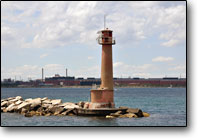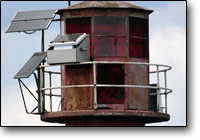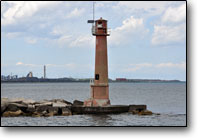Historical Information
While
it was steel that built the nearby harbors at Gary and Indiana harbor,
it was a by-product of the steel making process that served as the
nexus for the development of Buffington Harbor.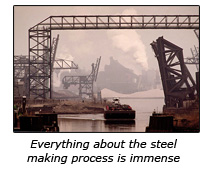 Everything
about the steel making process is immense, and being located at
the
foot of Lake Michigan, Chicago made the perfect location for steel
mills because of its location on the world's largest natural
fresh water highway and as central hub of the
nation's railway network. When the mills outgrew the confines
of Chicago itself, it was no suprise that they cast an eager
eye on the empty
dunelands to the east, with US Steel developing Gary
Harbor in 1905 and Inland Steel following with Indiana Harbor in
1910.Slag was
an inevitable by-product of the smelting process, and to avoid suffocating under its heavy
blanket, the steel companies began dumping slag into Lake Michigan to
create new land in which to expand. Indiana Harbor serves as the
quintessential example of this "slag expansion", with virtually all
of the expansive mill property reclaimed from the lake in this manner. Everything
about the steel making process is immense, and being located at
the
foot of Lake Michigan, Chicago made the perfect location for steel
mills because of its location on the world's largest natural
fresh water highway and as central hub of the
nation's railway network. When the mills outgrew the confines
of Chicago itself, it was no suprise that they cast an eager
eye on the empty
dunelands to the east, with US Steel developing Gary
Harbor in 1905 and Inland Steel following with Indiana Harbor in
1910.Slag was
an inevitable by-product of the smelting process, and to avoid suffocating under its heavy
blanket, the steel companies began dumping slag into Lake Michigan to
create new land in which to expand. Indiana Harbor serves as the
quintessential example of this "slag expansion", with virtually all
of the expansive mill property reclaimed from the lake in this manner.
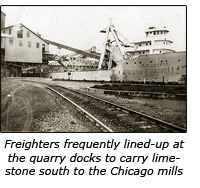 As
it happens, slag is not merely a useless by-product, since in
combination with powdered limestone it serves as the
primary raw material in
the
manufacture of high quality Portland cement. Already serving as
huge consumers of
limestone as a flux used in the smelting process, the mills were
receiving almost daily shipments of stone from massive
quarries throughout northern Michigan, and with a virtually
endless supplies of limestone and slag, the manufacture of Portland
cement repesented a natural areainto which the steel companies
could easily move and eventually dominate. As
it happens, slag is not merely a useless by-product, since in
combination with powdered limestone it serves as the
primary raw material in
the
manufacture of high quality Portland cement. Already serving as
huge consumers of
limestone as a flux used in the smelting process, the mills were
receiving almost daily shipments of stone from massive
quarries throughout northern Michigan, and with a virtually
endless supplies of limestone and slag, the manufacture of Portland
cement repesented a natural areainto which the steel companies
could easily move and eventually dominate.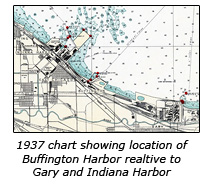 Illinois
Steel opened the first Portland cement operation in 1903. The
operation grew quickly and soon spun off as The Universal
Cement Company, and growing by leaps leaps and
bounds, space around Gary Harbor became a scarce and premium
commodity. As had been done by the Steel cmpanies previously,
Universal
began seeking a location to set up its own harbor
to facilitate this expansion, selecting a site between Gary and Indiana
Harbor. The name Buffington Harbor was selected in honor of E. J.
Buffington, who had been serving as President of Illinois Steel since
1898. Illinois
Steel opened the first Portland cement operation in 1903. The
operation grew quickly and soon spun off as The Universal
Cement Company, and growing by leaps leaps and
bounds, space around Gary Harbor became a scarce and premium
commodity. As had been done by the Steel cmpanies previously,
Universal
began seeking a location to set up its own harbor
to facilitate this expansion, selecting a site between Gary and Indiana
Harbor. The name Buffington Harbor was selected in honor of E. J.
Buffington, who had been serving as President of Illinois Steel since
1898. 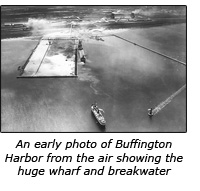 With
a total expected cost of $3,000,000, work at Buffington
Harbor began in the summer of 1925 with dredging of a sixty-acre deep
water turning basin. The eastern side of the harbor was created
through the construction of a 2,000 foot
long concrete
wharf at which vessels would tie-up to unload stone onto a
million-ton storage yard atop the wharf. To provide
protection from the northwest winds, work began on
a 1,200-foot rubble mound breakwater built of limestone cut and shipped
from the quarry at Calcite in northern Lake Huron. On
completion of the east pier on November 1, 1926 a 1.300 candlepower
acetylene pierhead light was exhibited from atop a white skeletal iron
tower at the piers outer end. With
a total expected cost of $3,000,000, work at Buffington
Harbor began in the summer of 1925 with dredging of a sixty-acre deep
water turning basin. The eastern side of the harbor was created
through the construction of a 2,000 foot
long concrete
wharf at which vessels would tie-up to unload stone onto a
million-ton storage yard atop the wharf. To provide
protection from the northwest winds, work began on
a 1,200-foot rubble mound breakwater built of limestone cut and shipped
from the quarry at Calcite in northern Lake Huron. On
completion of the east pier on November 1, 1926 a 1.300 candlepower
acetylene pierhead light was exhibited from atop a white skeletal iron
tower at the piers outer end.
As
work on the breakwater neared completion in early 1927, the company
needed a light at its outer end to guide vessels into the harbor, and
being a manufacturer of cement, there could be only one choice of
material
from which to build the structure, and that was concrete.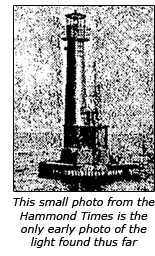 Designed
and constructed under the supervision of engineers of the Universal
Portland Cement Company, the new light structure was entirely cast
of concrete and stood atop a cylindrical concrete base 30 feet
in diameter and three feet thick. Rather than erecting this foundation
on a timber crib as was standard practice for the Army Corps
of Engineers
in breakwater construction, Universal instead incorporated a
stone-filled
ring of interlocking United States Steel sheet piling driven into the
lake bottom twenty-seven feet below to serve as the foundation. A
circular equipment room at the base of the structure housed a
compressor for the diaphragm fog signal, and received its power via a
submarine cable from shore. This equipment room also housed a pair of
acetylene tanks to serve as a backup light in the case of loss of
electrical service. The main shaft of the structure atop the mechanical
room stood seven feet in diameter and rose to a height of fifty feet
and was capped with an octagonal steel lantern. Within the lantern a
4,000 candlepower red incandescent electric lamp was designed to
provide a range of visibility of 13 miles in clear weather. Designed
and constructed under the supervision of engineers of the Universal
Portland Cement Company, the new light structure was entirely cast
of concrete and stood atop a cylindrical concrete base 30 feet
in diameter and three feet thick. Rather than erecting this foundation
on a timber crib as was standard practice for the Army Corps
of Engineers
in breakwater construction, Universal instead incorporated a
stone-filled
ring of interlocking United States Steel sheet piling driven into the
lake bottom twenty-seven feet below to serve as the foundation. A
circular equipment room at the base of the structure housed a
compressor for the diaphragm fog signal, and received its power via a
submarine cable from shore. This equipment room also housed a pair of
acetylene tanks to serve as a backup light in the case of loss of
electrical service. The main shaft of the structure atop the mechanical
room stood seven feet in diameter and rose to a height of fifty feet
and was capped with an octagonal steel lantern. Within the lantern a
4,000 candlepower red incandescent electric lamp was designed to
provide a range of visibility of 13 miles in clear weather. 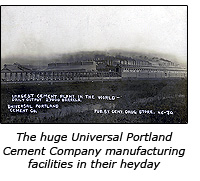 On
June 10, 1927, Buffington Harbor officially opened as US Vice President
Charles G Dawes arrived to a sixteen gun salute to join Illinois Steel
President E. J. Buffington, Universal Portland Cement Company President
B. F. Affleck as they raised the flag over the new harbor and toured
the facility to watch the company steamer EUGENE J BUFFINGTON unload a
ceremonial load of limestone.In
1995 then owners Lehigh Cement Company sold off most of the harbor to a
group of investors who established a pair of floating casinos. Today,
while the majority of vessels entering the harbor consist of pleasure
boats entering to tie up at the marina while their owners visit the
casinos, the Buffington Harbor light still shines from the end of the
breakwater. On
June 10, 1927, Buffington Harbor officially opened as US Vice President
Charles G Dawes arrived to a sixteen gun salute to join Illinois Steel
President E. J. Buffington, Universal Portland Cement Company President
B. F. Affleck as they raised the flag over the new harbor and toured
the facility to watch the company steamer EUGENE J BUFFINGTON unload a
ceremonial load of limestone.In
1995 then owners Lehigh Cement Company sold off most of the harbor to a
group of investors who established a pair of floating casinos. Today,
while the majority of vessels entering the harbor consist of pleasure
boats entering to tie up at the marina while their owners visit the
casinos, the Buffington Harbor light still shines from the end of the
breakwater.

Seeing
this Light
Because
the breakwater and
light are both on private property, and there are numerous large
buildings between any public access areas and the
lighthouse, the light is virtually impossible to see from the
land. Either a private boat or a vessel chartered from a local
fisherman
represent the only opportunities to obtain a good view of this light.
From time to time both the Great Lakes Lighthouse Keepers
Association and the United
States Lighthouse Society offer tours of the south end of
Lake Michigan, both of which have always provided great close-up views
of this and the other lighthouses of the area. GPS
Coordinates: 41°38'45.55"N x
87°24'37.28"W
Reference
sources
Cleveland Plain Dealer newspaper, various
Hammond Times newspaper, various
Pittsburgh National Labor Tribune, June 23, 1927
Great Lakes Light Lists, various
Great Lakes Coast Pilots, various
|
